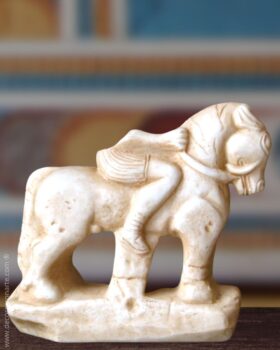IBERIANS AND PHOENICIANS- Archaeological reproductions.
IBERIANS AND PHOENICIANS- Archaeological and museum reproductions.
“Iberia is the name given to the part that falls on Our Sea (Mediterranean), starting from the columns of Heracles. But the part that falls towards the Great Sea or Outer Sea (Atlantic), has no common name to all of it, because it has only recently been recognised”.
(Polybius, Greek historian of the 2nd century BC who lived for a time in the Iberian Peninsula).
The Iberians developed their culture in the first millennium B.C., until the entry of the Romans in the 3rd century B.C., being at the crossroads between prehistory and the beginning of history.
In Iberian art we find sculpture and painting strongly influenced by the Tartessian culture, as well as writing derived from Phoenician and Greek writing.
They worked with different materials in sculpture: stone, bronze and terracotta, with great influence from Greek and Phoenician art. The sculptures of religious themes, idols, mythological animals, numerous figures of warriors on horseback and female figures such as the emblematic Lady of Elche or Lady of Baza stand out.
In terms of painting, they mainly used the colour red, ranging from dark red to almost orange and black. The main feature of their paintings were animal figures and plant motifs, and sometimes human figures.
Showing all 16 results
-


Lady of Elche. 57 cm
2.000€ Add to basket -


Lady of Baza (45x37cm)
436€ Add to basket -


Golden figure. Sphinx of Higuerones. 11cm
88€ Read more -


Fragment of Iberian relief. Hand holding shield. H:...
75€ Add to basket -
Sale!
Phoenician Medal S.I-II ad. (alt:14 cm)
Original price was: 75€.69€Current price is: 69€. Add to basket -
Iberian seated Lady (alt: 18 cm)
84€ Add to basket -
Iberian Warrior. (13,5 x 11,5 cm)
75€ Add to basket -
Iberian rider. Los Villares (Albacete). 21 x 20...
124€ Add to basket -
Iberian rider. Relief. Osuna (Seville). 16,5 x 16...
75€ Add to basket -
Iberian Flautist. 14,5 x 9 cm.
75€ Add to basket -
Breastplate with wolf. 16,5 x 13,5 cm.
75€ Add to basket -
Iberian Lady Offerer (H: 29cm)
95€ Add to basket -
Drunken Silenus. Iberian votive offering. Capilla (Badajoz). 8...
404€ Read more -
Warrior with mantle and broken spear. Iberian ex-voto....
266€ Read more -
Rider Despeñaperros III (Jaén). Iberian ex-voto. 15 x...
404€ Read more -
Bull Despeñaperros (Jaén).11 x 7 x 11 cm
396€ Read more


















